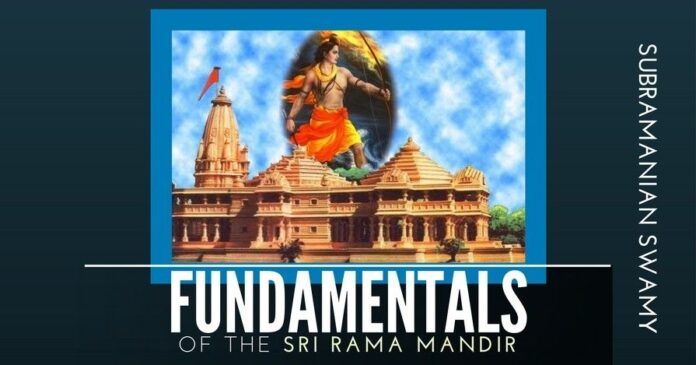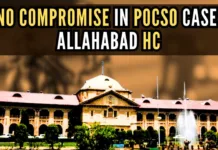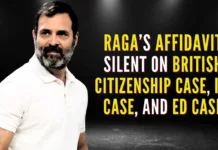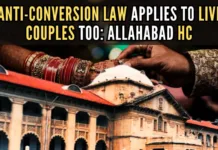
Fundamentals of the Sri Rama Temple
Subramanian Swamy
True and devout Hindus believe that Bhagvan Sri Rama was born in Ayodhya, the then capital of a flourishing kingdom of the Suryavamsa dynasty. Rama is venerated as Maryada Purushottam, and worshipped by Hindus of the north. As an avatar of Vishnu, while it was first propagated by the Tamil saints known as Nayanmars and Alwars who composed many hymns and songs dedicated to his divinity, the North which later came to accept Rama as one, especially thanks to the saint Tulsidas, the fervour for Rama worship is much more. In that sense, Sri Rama was the first truly national king of India, supra region, supra varna or jati. That is why poet Iqbal called him ‘Imam-e-Hind’.
The exact spot of the palace where Rama was born has been and remains firmly identified in the Hindu mind and is held as sacred. This is the very area where stood from 1528 till December 6, 1992, a structure that came to be known as Babri Masjid, put up in 1528 by foreign invader Babar’s commander, Mir Baqi.
In fact, Baqi was a Shia Muslim, and hence he intended it to be a place for Shias to read namaz. Today, interestingly, it is the Sunni Wakf Board, which entered the legal dispute as late as 1961. It has been litigating in the Supreme Court claiming the title to the land on which the structure once stood. At the Allahabad High Court level, Sunni Wakf Board claim to the title of the land was rejected. No Muslim party today claims the Babri Masjid must be rebuilt on where it once stood because Masjid can be demolished under Islamic law.
I call it a “structure” since it cannot be strictly called a mosque by Sunni edicts– because it did not have the mandatory minarets and wazu [water pool]. That a Ram temple existed and or that there is a sacred spot known as Ramjanmabhoomi is attested by many ancient sources and by modern scientific methods.
In Skanda Purana [Chapter X, Vaishnav Khand] the site is vividly described. Valmiki Ramayana also describes it beautifully. Less than two decades before Mir Baqi carried out the horrible demolition of the Ram Temple, Guru Nanak had visited the Ramjanmabhoomi and had darshan of Ramlala in the mandir at the spot.
There are many commentaries on this visit which are a part of the Sikh scriptures. Guru Nanak himself records the barbarity of Babar’s invasions [in Guru Granth Sahib at p.418]. In Akbar’s time, Abul Fazal wrote the Ain-i-Akbari in which he describes Ayodhya fame as the place of “Ram Chandra’s residence which in Treta age combined spiritual supremacy and Kingship” [Translated by Col. H.S. Jarrett and published in Kolkata in 1891].
In Chapter X of the Report of the Archeological Survey of India, NW and Oudh (1889), it is mentioned (p.67) that Babri Mosque “was built in AD 1528 by Mir Khan on the very spot where the old temple of Janmasthan of Ram Chandra was standing.”
Hindus throughout foreign occupation of India have deeply held as sacred that exact spot where the Babri Masjid once stood, as is recorded in many official and judicial proceedings. In 1885, for example, Mahant Raghubar Das in a Suit No 61/280 of 1885 filed in the Court of the Faizabad Sub-Judge against the Secretary of State for India (who was based in London), prayed for permission to build a temple on the chabutra outside the mosque. His suit was dismissed on March 18, 1886.
However, in his Order the Sub-Judge, an Englishman, stated thus: “ It is most unfortunate that a Masjid should have been built on land specially held sacred by the Hindus. But as the event occurred 358 years ago, it is too late now to remedy the grievance.” Since the English as policy never sought to disturb the social status quo in India as evidenced, for example, on the ‘Sati’ question, the Judge took the easy way out and dismissed the Suit.
It is now well established by GPRS- directed excavations done under the Allahabad High Court monitoring and verification in 2002-03, that a large temple did exist below where that Babri Masjid structure once stood. Inscriptions found during excavations describe it as a temple of Vishnu Hari who had killed the demon king Dasanan [Ravana].
The Sunni Wakf Board does not accept these findings as of any meaning or of any consequences. It does not, however, matter if all this was indeed so or not, since under Section 295 of the Indian Penal Code[IPC] it is prescribed that “Whoever destroys, damages or defiles any place of worship, or any object held sacred by any class of persons, with the intention of thereby insulting the religion of any class of persons or with the knowledge that any class of persons is likely to consider such destruction, damage or defilement as an insult to their religion, shall be punishable with imprisonment of either description for a term which may extend to two years, or with fine, or with both.”
That is, an offence under criminal law is committed if a body of persons hold something as sacred. It does not matter if the majority does or does not hold so. Nor can a court decide what is sacred and what is not. Only a body of persons can identify what is sacred. The offence under Section 295 IPC is cognizable and non-bailable, as well as non-compoundable.
The fundamental question before us is thus this: Can a temple and a masjid be considered on par as far as sacredness is concerned ? Relying on two important court judgments that hold the field today, the answer is: No! A masjid is not an essential part of Islam, according to a majority judgment of a Constitution Bench of India’s Supreme Court.
In the famous Ismail Farooqui vs Union of India case[reported in (1994) 6 SCC 376], the Supreme Court observed: “It has been contended that a mosque enjoys a particular position in Muslim law and once a mosque is established and prayers are offered in such a mosque, the same remains for all time to come a property of Allah…and any person professing Islamic faith can offer prayer in such a mosque, and even if the structure is demolished, the place remains the same where namaz can be offered” [para 80].
The Constitution Bench rebutted this contention stating: “The correct position may be summarized thus: Under Mohammed law applicable in India, the title to a mosque can be lost by adverse possession… A mosque is not an essential part of the practice of the religion of Islam and namaz (prayer) can be offered anywhere, even in the open. Accordingly, its acquisition is not prohibited by the provisions in the Constitution of India.”[para 82].
Thus, any Government depriving the Muslims of the Babri Masjid by an order of acquisition is within law, if the government decides to do so in the interest of public order, public health and morality [Article 25 of the Constitution]. The position in Islamic law is even more clear: in Saudi Arabia the authorities demolish mosques to lay roads and build apartment building. Even the mosque where Islam’s Prophet Mohammed used to pray was demolished!
But then what of a temple? Is it in the same category as the mosque in our jurisprudence? When I was Union Law and Justice Minister in 1990-91, this question of the status of a temple–even if in ruins or without worship–had come up before me in a case of a smuggled-out bronze Nataraja statue which was up for auction in London.
Earlier the Government of India, when Rajiv Gandhi was PM, had decided to file a case in the London trial court in 1986 for recovery. The Nataraja statue had by then been traced to a temple in ruins in Pathur, in Thanjavur district. A farmer named Ramamoorthi had in 1976 had accidentally unearthed it while digging mud with a spade near his hut.
When the news spread, touts of an antique dealer by the name Ahmed Hussein reached him and paid a small sum and smuggled it out to London, where in 1982 they sold it to Bumper Development Corporation Private Limited. In turn, the said Corporation sent it to the British Museum for appraisal and possible purchase. By then the Government of India was onto it and asked the UK government to take action.
The Nataraja idol was seized by London Metropolitan Police, and thus the Bumper Development Corporation sued the Police in court for recovery but lost the case. An appeal was filed in the Queens Bench [i.e., our High Court level] which was dismissed on April, 17 1989. So, the Bumper Corporation went to the House of Lords [our Supreme Court level]. On February 13, 1991 when I was Law Minister, the judgment came, which is truly landmark, dismissing Bumper’s final appeal [ see (1991) 4 All ER 638].
The House of Lords upheld the Indian government’s position that because of the prana prathista puja, a temple is owned by the deity, in this case Lord Shiva, and any Hindu can litigate on behalf of the deity as a defacto trustee. The Bench consisting of Justices Purchas, Nourse and Leggatt concluded: “We therefore hold that the temple is acceptable as party to these proceedings and that it is as such entitled to sue for the recovery of the Nataraja.” [page 648 para g].
Thus, even if a temple is in ruins as the ASI had found the Thanjavur temple or destroyed, as Ram Temple was in the Babri Masjid area, any Hindu can sue on behalf of Lord Rama in court for recovery! No such ruling exists for a mosque for the simple reason that a mosque is just a facilitation centre for reading namaz, and has no essentiality for Islam religion. It can be demolished and/or shifted as any building can and are being so today in Arab countries and Pakistan.
That is, the Ram Temple on Ramjanmabhoomi has a superior claim to the site than any mosque. This the fundamental truth in the Ayodhya dispute. This truth will apply, for example, to Kashi Vishvanath and Brindavan temple sites as well.
Therefore under law the Union Government can acquire the Babri Masjid site by a public notification, and urge the Muslim community to agree to shift the building of a new masjid to some other site well beyond and across the Saryu River.
It is important to note here that as of now there are eight mosques in Ayodhya area which the ASI has taken over since these had no one coming to read namaz. Hence what use will another mosque be?
Hence the national response to the judgment of Lucknow Bench of the Allahabad High Court allotting one-third of the Ramjanmabhoomi to the Sunni Wakf Board to build a mosque in the area near the Ramlala temple should be a resounding “No”! A temple cannot be equated to a mosque in either its immutability or its divinity. The masjid in Islamic law is just a building to facilitate reading of namaz, which anyway can be read anywhere.
Nor can we Hindus by the back door allow aggression and atrocity of demolishing temples be rewarded in any manner. Therefore, as with the Shah Bano case precedent, Government should bring an amendment to the Acquisition of Certain Areas of Ayodhya Act of 1993 to bar constructing any structure other than those connected with a temple for Sri Rama.
That will be the fit atonement of the so-called secular people of our nation for tacitly tolerating for so long the demolition of Ram Temple on the orders of Babar of Afghanistan. Babri, after whom the mosque is named incidentally was a 9-year boy in Kabul who was a “special” intimate of Babar with whom he was infatuated.
If such an amendment is not brought forth, Hindus should wage a fierce democratic struggle for the next 3½ years to force the government to do so or weld a solid Hindu Front supported by the Hindu Dharmacharyas, VHP and RSS can obtain an absolute majority in the Lok Sabha in the future.
From February 8, 2018, the Supreme Court will hear all the civil appeals plus my Writ Petition seeking enforcement of my fundamental right under Article 25 of the Constitution to worship at the spot where Hindus have faith Lord Ram was born. Since the Sunni Wakf Board is basing its argument of its rights to property, which is an ordinary right and not a fundamental right, hence under law my right is superior and overrides the Sunni Wakf Board claim of its ordinary right to property.
- Dr Swamy explains in-depth how Faith and Law is basis in Ayodhya judgment - December 17, 2017
- Subramanian Swamy’s article – Fundamentals of the Sri Rama Temple - December 6, 2017











राम मंदिर आस्था से अधिक सम्मान का विषय है . एक लुटेरा अपने बल को दर्शाने के लिए हमारे आस्था के प्रतीक को धूमिल करके हमारे सम्मान पर दाग लगाकर चला गया. अब जब हम उस दाग को मिटने का प्रयास का रहे है तो कुछ लोग उसका विरोध क्यों कर रहे है? संभवतया उनको इस दाग को देखकर हमारे मन में आने वाली हीन भावना से आनंद मिलता है और अपने को श्रेष्ठ मानने का कारण.
पर हमें हयेय दिखाने की पृवृत्ति से हमें मुक्ति चाहिए. इसीलिए वहां भव्य मंदिर बनना चाहिए.
ये तो वैसे ही है जैसे कोई बाहुबली हमारे घर का शीशा तोड़कर चला गया और जो लोग हमें नीचे दिखाना चाहते हैं, वो हमें उस टूटे हुए शीशे को ठीक नहीं करने दे रहे ताकि हमारा मनोबल समर्थ होने पर भी अपनी असहाय स्थिति के कारण नीचे रहे.
Brilliant article by Dr. Swamy. Dr. Swamy’s brilliance is clearly reflected in this article.
What about those that destroyed the Babri structure which led to communal riots.Hope some punishment also may be given to them.After Ayodhya,Dalits should unite to redress their historical grievances by approaching SC.After that all issues that divide us should have a closure.
Thank you Sri.Subramaniam Swamy & PGurus Team.
What an enormous scholarship, diligence and courage shown by Dr.SwamyDr.Swamy’s contribution to Ram Janmabhoomi and Ram Setu causes are invaluable. While elected government shies away in responding to rightful religious sentiments of the majority community, single handedly Dr.Swamy saved the Ram Setu. Hope he succeeds in his mission to get temple for Ram Lala at His birth place.
Subramanian Swamy’s invaluable contribution can never be paid back to him by Hindu Community except respecting him as “Guru”.
The productivity of an article should be felt in coming years. It is unevitable resource of our history to recall the issues from its base. The modern culture intrested in the origin based issues but the difficulty is that getting an rationalistic sum up of an issue. Now a day, the people called themselves as rationalist and just merge the single needed sentences as reference; not worried about ideology and methodology and objectives. It should be a single key of understanding on the above stated issue with its specific approach without any improper references. I admired by Dr. Subramanya Swamy ji. Most important man who always talk sharply on the issue without deviation or overriding……. hats off ji………..
We shall overcomes one day by efforts of you any all Hindus and by bless of Lord Ram ….good keep it up well done we thanks to you with all my Hindu families and familiars
[…] Dr. Swamy lays out a cogent argument for why the Ram Mandir should be constructed at the birth spot of Sri Rama, tracing the history of how a Masjid was built on top of a Ram Temple and quoting precedents on why Masjids can be moved but not temples https://www.pgurus.com/subramanian-swamys-article-fundamentals-of-the-sri-rama-temple/ […]
Swamy ji pranams
Very Good Article. If it can be converted in Hindi exactly and allowed to download as PDF, every Hindu will be able to read it. Jai Shree Ram!
It is in the process. Thank you for your support.
[…] Fundamentals of the Ram Temple – Dec 6, 2017, […]
It is a matter of pride for all indians particularly hindus that an intectual of Dr Swami’s stature has taken tha cause of Ram-Janambhumi Temple on himself.c His clear headed and scholarly arguments are intensely convincing. I am sure his efforts will succeed and RAM TEMPLE in Ayodhya will soon be a reality. Goodwishes of billions of Hindus and blessings of God’s are with him.
[…] Dr Subramanian Swamy’s article – *Fundamentals of the Sri Rama Temple* – MUST READ & W… […]
We must be grateful to Swamy jee for clarifying the issue. He must also go through Cat. ajit Vadakayil Blog
which givss WHAT such info as –Mir Baki Hijra-so in Islam it is not permitted, Badri Mosque does not follow Mooque pattern, for it has no Minarets, No Washng facility Wazra-and above all NO NAMAZ FOR EVER PERFORMED THERE AS THE PILLARS UNDERNEATH BORE VARAHA- PIG -FIGURES—-AND PIG IS ANATHEMA TO MUSLIMS–ISLAM DOES NOT PERMIT A RELIGIOUS SITE OF ANOTHER RELIGION TO BE USED FOR MOSQUE CONSTRUCTION——-SUGGEST THROUGH MEDIA VARIOUS ITEMS EXCAVATED PERTAINING TO RAMA TEMPLE SHOULD BE SHOWN TO PEOPLE AND PEOPLE SHOULD BEALLOWED TO VISIT THE TEMPLE SITE AND SEE FOR THEMSELVES THE TELL TALE EVIDENCE OF HINDU RAM TEMPLE
An informative and eye opening article for all true Hindus to be read
Mr Subramaniam Swamy – a huge thanks to you for your relentless pursuit of the case. Hope we are able to celebrate 2018 Deepavali at the Ayodhya mandir.
My prayers for your success in this as well as other causes taken up by you.
it puzzles me,why god and dog are so close.both have 3 letters.read god in reverse it becomes d o g “dog”.a human can be born as a dog in his next birth if he does sins in this life.some humans think and act worse than dogs.so dont insult dogs by equating them with such ppl.
Battle for Bhārat’s ātmā. Right to Property of Ayodhya for Ram Mandir is a Constitutional Right of Ram Lalla
Great knowledge. Must reach every citizen, mostly Hindus.
Islamophobic guy. He must be nightmaring Islamic dominance. His son in law is a Muslim.
You can ask him to revolt against his fr-in-law.
”Mohd al Arifi Saudi wahabi cleric says ” arabs are the true muslims & true descendants of prophet mohd” ” Non Arabs who without shame call themselves muslims are just plain Converts who are lowly cowards with unhonourable souls that were overwhelmed with ease by the swords of allah, thus they deserve to be called as our dogs”
Sir you are GOD to us
Swamiji is great. Pray Sri Ram to give him sound health and long life.
Subramanian (Swamy) is verily the Guha of Sri Rama.
Hindus should stand united otherwise every effort will be made by sicular communal liberal intelligentsia along with antinational parties,paid media to weaken the country.
Awesome!!!! quite clear and convincing for all. Brilliant piece of article. Jai Sri Ram..
[…] Dr. Swamy lays out a cogent argument for why the Ram Mandir should be constructed at the birth spot of Sri Rama, tracing the history of how a Masjid was built on top of a Ram Temple and quoting precedents on why Masjids can be moved but not temples https://www.pgurus.com/subramanian-swamys-article-fundamentals-of-the-sri-rama-temple/ […]
New drama will get enacted on 08 Feb 18 unless Apex court puts it foot down that those not willing to argue can do so at the peril of their respective client(s)
Bravo ! Subramanian swamy. The country owes a huge thanks to you for your relentless efforts in the Ram janma bhoomi case. The whole nation will pray for your success in this case.